ADR (treaty)
ADR (formally, the European Agreement concerning the International Carriage of Dangerous Goods by Road (ADR)) is a 1957 United Nations treaty that governs transnational transport of hazardous materials. "ADR" is derived from the French name for the treaty: Accord européen relatif au transport international des marchandises Dangereuses par Route).
Concluded in Geneva on 30 September 1957 under the aegis of the United Nations Economic Commission for Europe, it entered into force on 29 January 1968. The agreement was modified (article 14, paragraph 3) in New York City on 21 August 1975, though these changes only took effect on 19 April 1985. A new amended ADR 2011 entered into force on 1 January 2011. Annexes A and B have been regularly amended and updated since the entry into force of ADR. Consequently to the amendments for entry into force on 1 January 2015, a revised consolidated version has been published as document ECE/TRANS/242, Vol. I and II.[1]
As of 2016, 49 states are party to ADR.[2]
Contents
The agreement itself is brief and simple, and its most important article is article 2. This article states that with the exception of certain exceptionally dangerous materials, hazardous materials may in general be transported internationally in wheeled vehicles, provided that two sets of conditions be met:
- Annex A regulates the merchandise involved, notably their packaging and labels.
- Annex B regulates the construction, equipment, and use of vehicles for the transport of hazardous materials.
The appendices consist of nine chapters, with the following contents
- General provisions: terminology, general requirements
- Classification: classification of dangerous goods
- Dangerous Goods List sorted by UN number, with references to specific requirements set in chapters 3 to 9; special provisions and exemptions related to dangerous goods packed in limited quantities
- Packaging and tank provisions
- Consignment procedures, labeling, and marking of containers and vehicles.
- Construction and testing of packagings, intermediate bulk containers (IBCs), large packagings, and tanks
- Conditions of carriage, loading, unloading, and handling
- Vehicle crews, equipment, operation, and documentation
- Construction and approval of vehicles
Hazard classes
The classes of dangerous goods according to ADR are the following:
- Class 1 Explosive substances and articles
- Class 2 Gases, including compressed, liquified, and dissolved under pressure gases and vapors
- Flammable gases (e.g. butane, propane, acetylene)
- Non-flammable and non-toxic, likely to cause asphyxiation (e.g. nitrogen, CO2) or oxidisers (e.g. oxygen)
- Toxic (e.g. Chlorine, Phosgene)
- Class 3 Flammable liquids
- Class 4.1 Flammable solids, self-reactive substances, and solid desensitized explosives
- Class 4.2 Substances liable to spontaneous combustion
- Class 4.3 Substances which, in contact with water, emit flammable gases
- Class 5.1 Oxidizing substances
- Class 5.2 Organic peroxides
- Class 6.1 Toxic substances
- Class 6.2 Infectious substances
- Class 7 Radioactive material
- Class 8 Corrosive substances
- Class 9 Miscellaneous dangerous substances and articles
Each entry in the different classes has been assigned a 4 digit UN number. It is not usually possible to deduce the hazard class(es) of a substance from its UN number: they have to be looked up in a table. An exception to this are Class 1 substances whose UN number will always begin with a 0. See List of UN numbers
ADR pictograms
ADR pictograms for chemical hazards are based on GHS Transport pictograms and Non-GHS transport pictograms
-
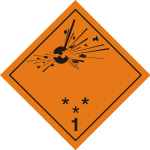
1-Explosives
-
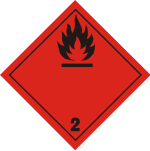
2.1-Flammable gases
-
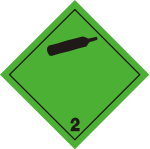
2.2-Non-toxic and non-flammable gases
-
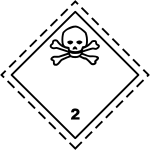
2.3 Poison gases
-

3-Flammable liquids
-

4.1-Flammable solids
-
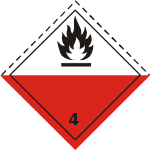
4.2-Spontaneously combustibles
-

4.3-Dangerous when wet
-

5.1-Oxidizers
-
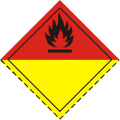
5.2-Organic peroxides
-

6.1-Poison
-
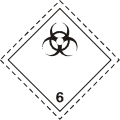
6.2-Infectious substances
-
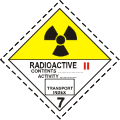
7-Radioactive
-

8-Corrosive
-

9-Miscellaneous dangerous substances
See also
- European hazard symbols
- Hazchem — a system used in the United Kingdom, Australia, and New Zealand for marking dangerous goods
- ATEX directive — two EU directives governing permitted equipment in explosive environments
References
Notes
Sources
- "European Agreement concerning the International Carriage of Dangerous Goods by Road" on the United Nations Economic Commission for Europe website
External links
| Wikimedia Commons has media related to ADR labels of danger. |
- Full text of the ADR 2015
- How to assign a UN Number and proper shipping name
- ADR 2009 SDSs
- Forum ADR
- ADR App